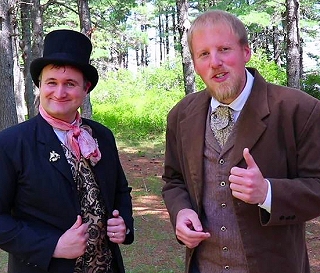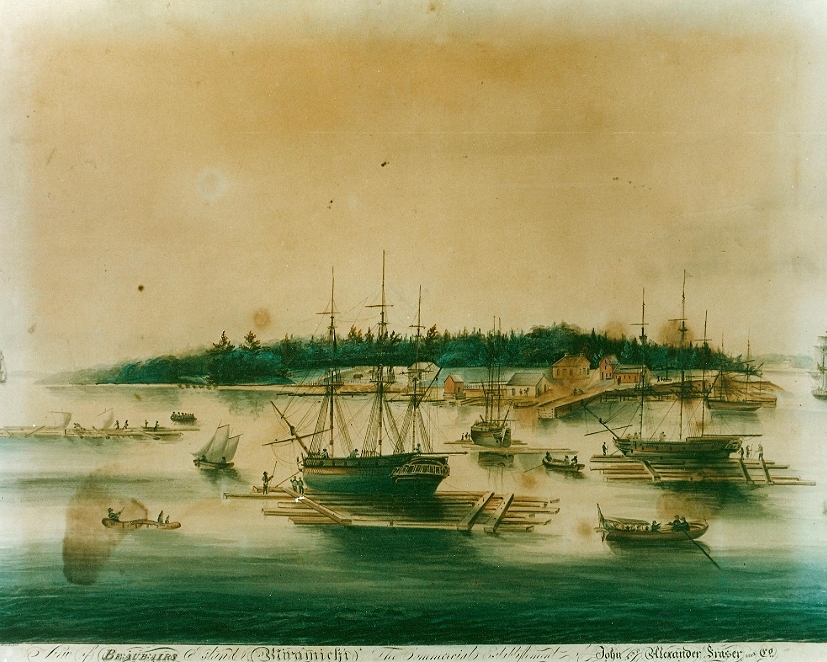 By Thomas G. Daley and Shawn J. McCarthy, PhD,
By Thomas G. Daley and Shawn J. McCarthy, PhD,Friends of Beaubears Island
It has been argued that interactive and character-based experiences are the future for New Brunswick and its many museums and heritage sites. While costumed re-enactment can never replace the value of an artifact, or stand substitute for a historic property, it can certainly lend greater worth to both, by taking history off the page, so to speak. What follows is a very brief description of the process of implementing an interactive character offering.
In the beginning, it can sometimes feel as though the inclusion of a character will act as a tonic, solving problems while creating new, and exciting opportunities. While this is possible, with a good deal of hard work, it is better, at the outset, to consider the addition of a character as an important, but not paramount, piece of the overall guest experience. When deciding how a character will contribute to this, it is best to consult interpretive plans and strategies, however informal, for gaps in the overall interpretive narrative, or stories that might benefit from a first-person narrator.
Now that a decision has been made to feature a character, the next conceptual step is to decide what sort of character is best suited; someone specific, or someone who represents the lives of a large group of people? Put simply, there are, very broadly, two distinct types of historical characters – those who represent actual people who lived (often whose contribution to history is notable), and those who are completely fabricated, but who serve to represent a larger group or community in which the contribution of all members produces a larger historical narrative that is greater, or more easily accessed, than the narrative of any particular individual.
Up to this point there has been much to consider, but, with the onset of research, the real work begins. Primary source documents should be a focal point, as they permit a performer to speak the words, or espouse the feelings, of the person they are portraying. Moreover, sources like newspapers provide context from the time – events which occurred, weather, various bits of trivia – all of which can be useful in the formation of any character. Where possible, also look to secondary source material, especially where authors have had access to sources presently unavailable. Archival staff, librarians, local historical societies, amateur historians/genealogists, and research assistants available through post-secondary institutions, can be of immense assistance, and it is always a good idea to nurture contacts in the archival and academic communities wherever possible.
The writing of the script can feel daunting task, but a graduated approach is advisable. Be sure of the character’s purpose, beyond simply reiterating information found in displays, or previously relayed by a guide. Always remember, the script is trying to interpret history, not be a rigidly fact-driven source of information. It is likely best that a first effort at a script take the form of a one-page monologue, where the absolute essentials of the character are in place. From there, take the time to fill out any details that might be lacking. Above all, when writing, treat these personas as “regular people”; a character that is too much of a parody, or, conversely, too idealized, will not seem real and lack resonance with your audiences. Once a working draft feels complete, read the whole thing aloud, as the character might. Is the script accurate, but also, does it make sense and tell its story coherently, with sufficient room for artistic interpretation?
When interviewing perspective candidates to fill your role, two general qualities are sought after– a knowledge of the history, and the ability to present the material in a dynamic, engaging, and authentic way. A costumed historian, narrating stories of the past in the first person, is no more the intended goal than is a character speaking about a historical period they clearly know very little about.
 Costumes are an indispensable part of any character, and due care should be taken to make sure a character looks their very best. Appropriate period dress is strongly advised, though this is not to say that such clothing cannot be re-purposed from more modern apparel, or materials. Second hand and vintage stores are therefore worth investigating in hopes of finding unique items for a fraction of the price that can be turned into something exceptional with a few alterations. In most cases, professionally made costumes are best, as they are made to be worn, and worn often. Theatrical costumes are serviceable for a few years, provided they are well maintained, but very often these types of clothes have not been designed for regular daily use, and will need regular maintenance and replacement, costing more money over time.
Costumes are an indispensable part of any character, and due care should be taken to make sure a character looks their very best. Appropriate period dress is strongly advised, though this is not to say that such clothing cannot be re-purposed from more modern apparel, or materials. Second hand and vintage stores are therefore worth investigating in hopes of finding unique items for a fraction of the price that can be turned into something exceptional with a few alterations. In most cases, professionally made costumes are best, as they are made to be worn, and worn often. Theatrical costumes are serviceable for a few years, provided they are well maintained, but very often these types of clothes have not been designed for regular daily use, and will need regular maintenance and replacement, costing more money over time.
With everything set in motion, it’s time to ramp up promotion for the character experience. Promotion takes place in many forms, yet the visual media is likely best for a character; they are meant to be seen. Photos and videos give a distinct impression, and can be easily, and inexpensively, circulated through social media platforms. Look for ways to cross promote – have dialogues with other organizations and events in your area that would welcome exposure as well.
Personal appearances by a character(s), at local festivities or events, are also a good way to generate conversation; consider Canada Day celebrations, as they are positioned well to inaugurate the peak visitation season. Whenever possible, encourage local media and local front line staff to visit and meet the character, by offering free tours if needed, and have guests speak about their experience on travel sites. Put simply, the word of an unbiased third party, or, better yet, several parties, will go some way to inciting visitation.
Maintain good communication with the performer throughout the year to exploit the presentation’s strengths, discuss challenges, and address concerns. Speak to other staff, and solicit the opinions of guests where possible; consider all reviews, positive and negative. At the close of the season, compare notes with the performer and decide what worked about the experience and what did not. The best expansion to contemplate in the off-season is how to better enhance the existing product, by building on what worked best and working on problem areas in order to find a more precise balance.
Once one character is fully developed and actualized, it is usually easier to create more. This potentially gives the benefit of being able to create scenes between various characters. With time and commitment, this creates the opportunity to grow into an engaging experience that educates and entertains visitors for years to come.
Thomas Daley graduated from the Vancouver Film School’s Acting for Film and Television Program with honours. He has worked in historical based tourism for over 15 years, offering a uniquely developed entertaining and educational experience to people from all over the world. With stage and screen credits in productions from Vancouver to Sweden, he has been exposed to a wide range of arts and culture.
A doctoral graduate of Western University, Shawn McCarthy specializes in experiential heritage offerings, utilizing on-site, character-based, re-enactment. During his 19 year tenure at the Boishébert / Beaubears Island Shipbuilding National Historic Sites of Canada, he has worn many hats, both figuratively and literally. He is a a two-time author, and has lectured for the University of New Brunswick.





